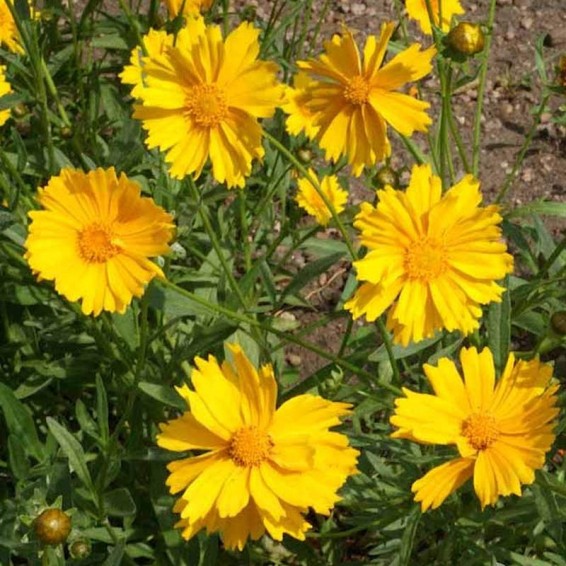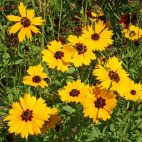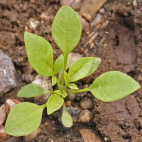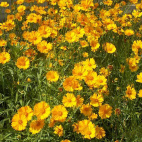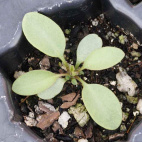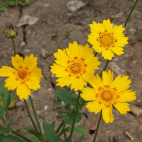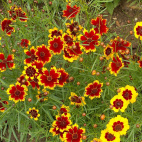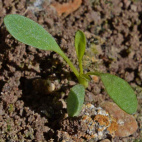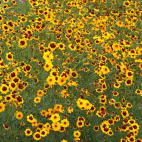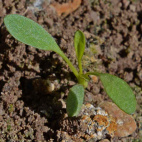Dwarf Lance Leaved Coreopsis Seeds
- HOW TO GROW
- FAST FACTS
- REVIEWS
HOW TO GROW
Sowing: Direct sow in late fall, planting the seed just below the surface of the soil; these dwarf lance leaved coreopsis seeds need light to germinate. For spring planting, mix the seed with moist sand and store it in the refrigerator for 30 days before direct sowing. Keep the soil evenly moist until germination, which should occur within 10-15 days. The treated seeds can also be started indoors 6-8 weeks before the last frost of spring; plant the seeds on the surface of a flat, keeping the moisture consistent and the temperature around 65 degrees F. Transplant seedlings.
Growing: This plant adapts to nearly any soil, including rocky or shallow areas or seaside conditions. Water the seedlings occasionally until they become established; mature plants prefer dry soil and tolerate drought, heat, and humidity well. If given too much moisture or rich soil, the plants tend to flop and may need support. If the blooming decreases midseason, cut the plant back by half for new growth and blooms. Regular deadheading also helps prolong the season of blooming. If allowed to self-seed it will produce volunteer plants, though it does not become weedy. For the healthiest growth, divide plants in the spring or fall after several years of growth. This plant attracts butterflies and bees as well as resisting rabbits and deer.
Harvesting: For long lasting fresh flowers, cut the stems long and place them in water immediately.
Seed Saving: Several weeks after the flowers have faded, the seed heads will turn dry and dark brown. Since these dwarf lance leaved coreopsis seeds are a favorite food of songbirds and rodents, harvest them promptly. Cut the heads from the plant and spread them out to dry completely. Break them apart to remove the seeds, and separate the seeds from the chaff. Store the dwarf lance leaved coreopsis seeds in a cool, dry place.
FAST FACTS
Common Names: Lanceleaf Coreopsis, Tickseed Coreopsis, Lanceleaf Tickseed, Lance-leaved tickseed, tickseed
Latin Name: Coreopsis lanceolata
Species Origin: US Native Wildflower
Type: Native Wildflowers
Life Cycle: Perennial
USDA Zones: 3, 4, 5, 6, 7, 8, 9, 10, 11, 12
US Regions: California, Mountain, Arid/Desert, Plains/Texas, Midwest, Northern, Northeast, Southeast
Seeds per Ounce: 13,000
Stratification: Cold/Wet for 4 Weeks
Germination Ease: Stratify 4 Weeks
Sunlight: Full Sun, Part Sun
Height: 16 Inches
Color: Yellow
Bloom Season: Blooms Late Summer, Blooms Early Fall
Uses: Attracts Pollinators, Attracts Butterflies, Cut Flowers, Deer Resistant
Quality seeds
I buy from Everwilde because they have a good selection of quality seed; dated and well-packaged, with quick delivery. We have a 1.5 acre wildflower field, to which we continue to add additional flowers. We mow it in late October, then broadcast new seeds for winter and then spring germination. Many of these flowers have popped up throughout the field.
DESCRIPTION
-Distribution-Map.jpg)
HOW TO GROW
Sowing: Direct sow in late fall, planting the seed just below the surface of the soil; these dwarf lance leaved coreopsis seeds need light to germinate. For spring planting, mix the seed with moist sand and store it in the refrigerator for 30 days before direct sowing. Keep the soil evenly moist until germination, which should occur within 10-15 days. The treated seeds can also be started indoors 6-8 weeks before the last frost of spring; plant the seeds on the surface of a flat, keeping the moisture consistent and the temperature around 65 degrees F. Transplant seedlings.
Growing: This plant adapts to nearly any soil, including rocky or shallow areas or seaside conditions. Water the seedlings occasionally until they become established; mature plants prefer dry soil and tolerate drought, heat, and humidity well. If given too much moisture or rich soil, the plants tend to flop and may need support. If the blooming decreases midseason, cut the plant back by half for new growth and blooms. Regular deadheading also helps prolong the season of blooming. If allowed to self-seed it will produce volunteer plants, though it does not become weedy. For the healthiest growth, divide plants in the spring or fall after several years of growth. This plant attracts butterflies and bees as well as resisting rabbits and deer.
Harvesting: For long lasting fresh flowers, cut the stems long and place them in water immediately.
Seed Saving: Several weeks after the flowers have faded, the seed heads will turn dry and dark brown. Since these dwarf lance leaved coreopsis seeds are a favorite food of songbirds and rodents, harvest them promptly. Cut the heads from the plant and spread them out to dry completely. Break them apart to remove the seeds, and separate the seeds from the chaff. Store the dwarf lance leaved coreopsis seeds in a cool, dry place.
FAST FACTS
Common Names: Lanceleaf Coreopsis, Tickseed Coreopsis, Lanceleaf Tickseed, Lance-leaved tickseed, tickseed
Latin Name: Coreopsis lanceolata
Species Origin: US Native Wildflower
Type: Native Wildflowers
Life Cycle: Perennial
USDA Zones: 3, 4, 5, 6, 7, 8, 9, 10, 11, 12
US Regions: California, Mountain, Arid/Desert, Plains/Texas, Midwest, Northern, Northeast, Southeast
Seeds per Ounce: 13,000
Stratification: Cold/Wet for 4 Weeks
Germination Ease: Stratify 4 Weeks
Sunlight: Full Sun, Part Sun
Height: 16 Inches
Color: Yellow
Bloom Season: Blooms Late Summer, Blooms Early Fall
Uses: Attracts Pollinators, Attracts Butterflies, Cut Flowers, Deer Resistant
Reviews
Review
Quality seeds
I buy from Everwilde because they have a good selection of quality seed; dated and well-packaged, with quick delivery. We have a 1.5 acre wildflower field, to which we continue to add additional flowers. We mow it in late October, then broadcast new seeds for winter and then spring germination. Many of these flowers have popped up throughout the field.
Also Consider These:
-
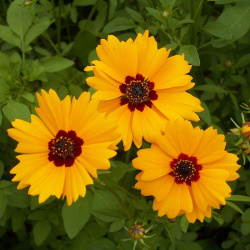 Golden Wave Tickseed Seeds
Coreopsis basalis
Quick View
x
Golden Wave Tickseed Seeds
Coreopsis basalis
Quick View
xGolden Wave Tickseed Seeds
Starting at $2.98 USD -
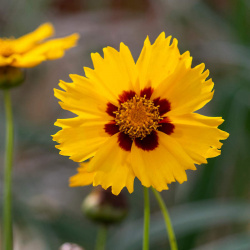 Large Flowered Tickseed Seeds
Coreopsis grandiflora
Quick View
x
Large Flowered Tickseed Seeds
Coreopsis grandiflora
Quick View
xLarge Flowered Tickseed Seeds
Starting at $2.98 USD -
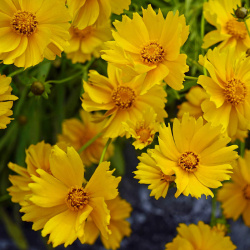 Sand Coreopsis Seeds
Coreopsis lanceolata
Quick View
x
Sand Coreopsis Seeds
Coreopsis lanceolata
Quick View
xSand Coreopsis Seeds
Starting at $2.98 USD -
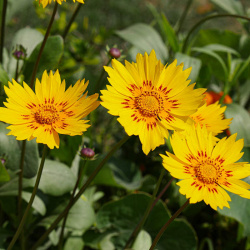 On Sale!
Picta Tickseed Seeds
Coreopsis nuecensis
Quick View
x
On Sale!
Picta Tickseed Seeds
Coreopsis nuecensis
Quick View
xPicta Tickseed Seeds
Coreopsis nuecensis
Also known as Crown Tickseed, this charming yellow wildflower features a ring of deep red within the petals. Very easy to grow and great for wildflower mixes and planters.
Starting at $3.25 USD -
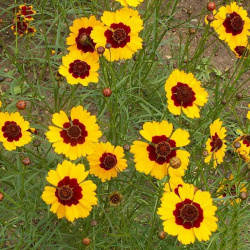 Dwarf Plains Coreopsis Seeds
Coreopsis tinctoria
Quick View
x
Dwarf Plains Coreopsis Seeds
Coreopsis tinctoria
Quick View
xDwarf Plains Coreopsis Seeds
Starting at $2.98 USD -
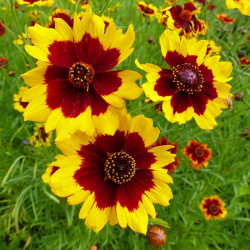 Plains Coreopsis Seeds
Coreopsis tinctoria
Quick View
x
Plains Coreopsis Seeds
Coreopsis tinctoria
Quick View
xPlains Coreopsis Seeds
Starting at $2.98 USD
